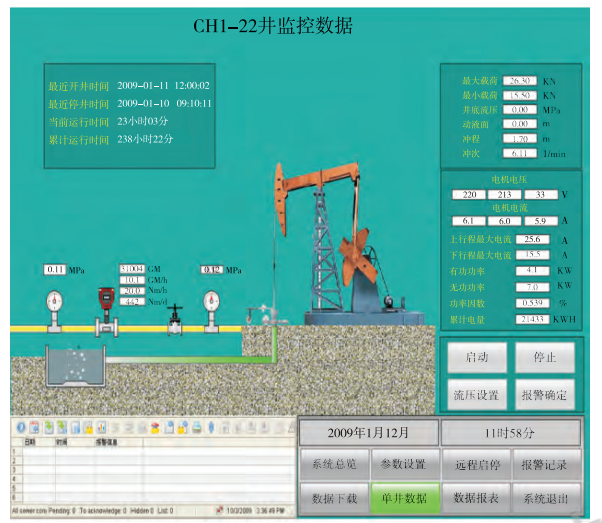rtu control system application in oil fields
In order to realize single well automation and intelligent drainage and production, an oilfield RTU control was developed with the currently internationally accepted programmable controller PLC as the core and easy to configure on-site automation control, equipped with high-reliability input and output modules, power acquisition modules and GPRS modules. system. The system adopts key technologies such as large-capacity storage, low energy consumption, wireless testing, and wireless data transmission to adapt to the harsh working environment in the field. It has stable performance, safety and reliability, is easy to use, and has rain-proof, sand-proof, and anti-theft functions. By conducting research on the application of PLC technology in this control system, the balance and stroke frequency of the beam can be automatically adjusted to achieve intelligent drainage, so that the entire system such as the pumping unit, sucker rod, and pump can achieve optimal coordination and improve system efficiency. , significantly reducing workers’ labor intensity and promoting the construction of smart oil fields.

Domestic coalbed methane is in a period of rapid development. Most of the coalbed methane is still carried out by manual well searching without intelligent drainage. In order to realize the automation of single wells, the use of intelligent drainage is an urgent problem that needs to be solved. In the mid-1980s, some foreign manufacturers took advantage of their advantages in data acquisition, conversion and communication to launch a remote measurement and control terminal system (RTU) using single-chip microcomputer technology, and used the RTU and a host computer to form a simple SCADA system. In the late 1990s, while absorbing foreign products, some domestic petroleum automation research institutes also successively launched RTUs specifically for oil pumping units with single-chip microcomputers as the main form. However, the microcontroller motherboard in the RTU has not been able to form industrial mass production. During field application, RTU failures often occur, remote data lacks accurate, timely and reliable transmission, and on-site maintenance and repair workload is heavy. Since entering the 21st century, with the continuous improvement and popularization of oilfield automation level, in the oilfield SCADA system, an RTU with timely transmission, reliable performance and stable operation is essential. To this end, the current internationally accepted programmable controller PLC, which is easy to configure on-site automation control, is used as the core to replace the single-chip data acquisition motherboard in the RTU, and the application of PLC technology in the oilfield RTU control system is studied. It is also equipped with a high-precision power collection module and a multi-channel analog input and output module, and uses GPRS wireless communication to realize a remote measurement and control station RTU with high performance and high reliability for transmitting on-site data. It can form an RTU with industrial mass production, strong versatility, high reliability, stable performance, and timely and accurate data transmission. Ensure trouble-free and safe operation for more than 5 years and a service life of more than 20 years to facilitate standardized market management.
Field tests and applications
1.1 Field test
1.1.1 Test method
The actual data of the pumping unit is collected to the programmable PLC through the load sensor and angular displacement sensor, and the historical data is uploaded to the host computer to generate a dynamometer diagram. First, fix the angular displacement sensor on the oil beam of the pumping unit to ensure that the top of the sensor and the oil beam are on the same level and they remain parallel. Secondly, the installation of the load sensor requires steel plates, angle irons, steel cables, fixed steel clips, etc. The steel cables are used to transmit signals, and the steel plates, angle irons, and fixed clips are used to fix the steel cables.
1.1.2 Test procedures
(1) Sensor signal test: The switching power supply provides 12V power supply for the angular displacement sensor and 5V power supply for the load sensor. Use a multimeter to measure the output value of the load sensor in the range of 0.8 ~ 1.5V. The output value of the angular displacement sensor Within the range of 6~15mA.
(2) Connect the load sensor signal line and angular displacement sensor signal line to the S7-200PLC analog input module respectively.
(3) The upper computer is two laptop computers. One is used for software programming and control, using CP5512 card, adapter and PROFIBUS-DP communication line to connect to S7-200PLC (PROFIBUS-DP communication line protocol); the other is used for real-time monitoring of dynamometer diagram, using PPI communication line Connect with S7-200PLC (PPI communication protocol).
(4) Prepare load and displacement signal acquisition programs, modify and debug and conduct data collection.
(5) Historical data display.
1.1.3 Test results
Through on-site experiments, it was verified that the programming, operation screens, and completed functions of the remote terminal RTU control system fully meet user requirements and on-site process conditions. At the same time, after the software program is mature, it can be downloaded directly to multiple devices, shortening debugging time and debugging costs.
1.2 Development and application situation
Nearly 400 sets of RTU control systems have been put into operation in Fanzhuang and Chengzhuang of Shanxi coalbed methane, and have been operating without fault for more than 500 days. Data collection and transmission are timely, accurate and reliable, and are well received by users. Preparations are currently being made for the recent development of Zhengzhuang coalbed methane, and 300 sets of RTUs are expected to be invested.
Keywords: rtu control system application